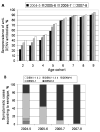Trends in patterns of dengue transmission over 4 years in a pediatric cohort study in Nicaragua
- PMID: 19929380
- PMCID: PMC3724236
- DOI: 10.1086/648592
Trends in patterns of dengue transmission over 4 years in a pediatric cohort study in Nicaragua
Abstract
Background: Dengue is the most prevalent mosquito-borne viral disease in humans and a major urban public health problem worldwide.
Methods: A prospective cohort study of approximately 3800 children initially aged 2-9 years was established in Managua, Nicaragua, in 2004 to study the natural history of dengue transmission in an urban pediatric population. Blood samples from healthy subjects were collected annually prior to the dengue season, and identification of dengue cases occurred via enhanced passive surveillance at the study health center.
Results: Over the first four years of the study, seroprevalence of anti-dengue virus (DENV) antibodies increased from 22%-40% in the 2-year-old cohort and 90%-95% in the 9-year-old cohort. The incidence of symptomatic dengue cases and the ratio of inapparent to symptomatic DENV infection varied substantially from year to year. The switch in dominant transmission from DENV-1 to DENV-2 was accompanied by an increase in disease severity but, paradoxically, a decrease in transmission. Phylogeographic analysis of full-length DENV-2 sequences revealed strong geographic clustering of dengue cases.
Conclusions: This large-scale cohort study of dengue in the Americas demonstrates year-to-year variation of dengue within a pediatric population, revealing expected patterns in transmission while highlighting the impact of interventions, climate, and viral evolution.
Figures





References
-
- Guzman MG, Kouri G. Dengue and dengue hemorrhagic fever in the Americas: lessons and challenges. J Clin Virol. 2003;27:1–13. - PubMed
-
- Kouri G, Valdez M, Arguello L, et al. Dengue epidemic in Nicaragua, 1985. Rev Inst Med Trop Sao Paulo. 1991;33:365–71. - PubMed
-
- Balmaseda A, Hammond S, Pérez L, et al. Serotype-specific differences in clinical manifestations of dengue. Am J Trop Med Hyg. 2006;74:449–56. - PubMed
-
- Harris E, Videa E, Perez L, et al. Clinical, epidemiologic, and virologic features of dengue in the 1998 epidemic in Nicaragua. Am J Trop Med Hyg. 2000;63:5–11. - PubMed
Publication types
MeSH terms
Grants and funding
LinkOut - more resources
Full Text Sources
Medical

